WSDOT’s 520 Replacement design team is back at it again, after taking 2013 off for lack of funding. They recently updated the design options for the future Portage Bay Bridge in a presentation to the Seattle Design Commission. The options were narrowed down to two bridge types at the end of the 2012 Community Design Process: cable stay or box girder. The goal with the fresh design update is to have a better-vetted design option ready to impress lawmakers in Olympia deciding on 520 funding during the next legislative session (expect a public open house announcement soon). Check out the updated design drawings and take a quick poll below.
Cable stay:
Box girder:
Here’s another look. Cable stay:
Box girder:
And yet another view, from the multi-use path. Cable stay:
Box girder:
There you have it. The Seattle Design Commission debated the merits of each bridge type at its July 17th meeting and didn’t seem to reach an obvious consensus during discussion. The cable stay option is by far the more expensive of the two, has nine towers and has a thinner road deck. The box girder option costs less, has a thicker deck and is aesthetically more minimal. Made up your mind? Time for some democracy.
Thoughts? Put ’em in the comments or take no prisoners on the Montlake Forum. More updated drawings and info for the Portage Bay Bridge replacement can be found here and at Montlake.net’s Everything 520 page.
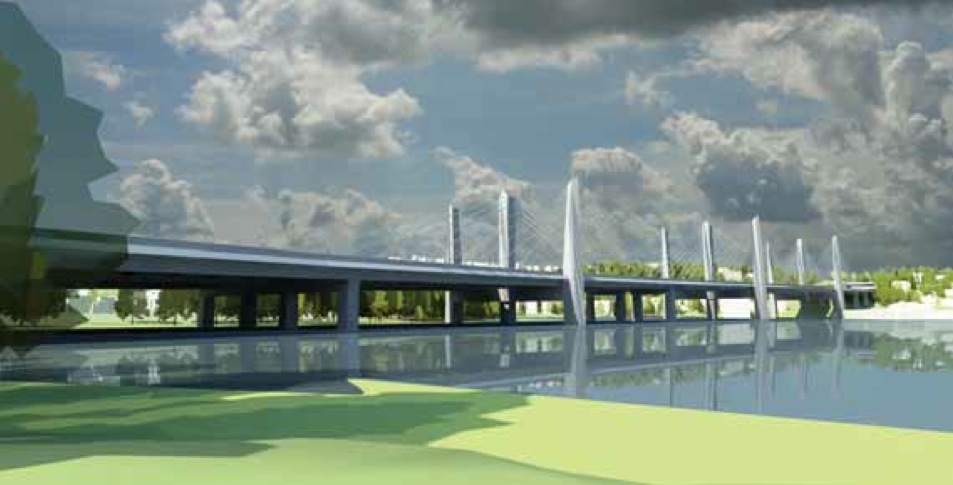

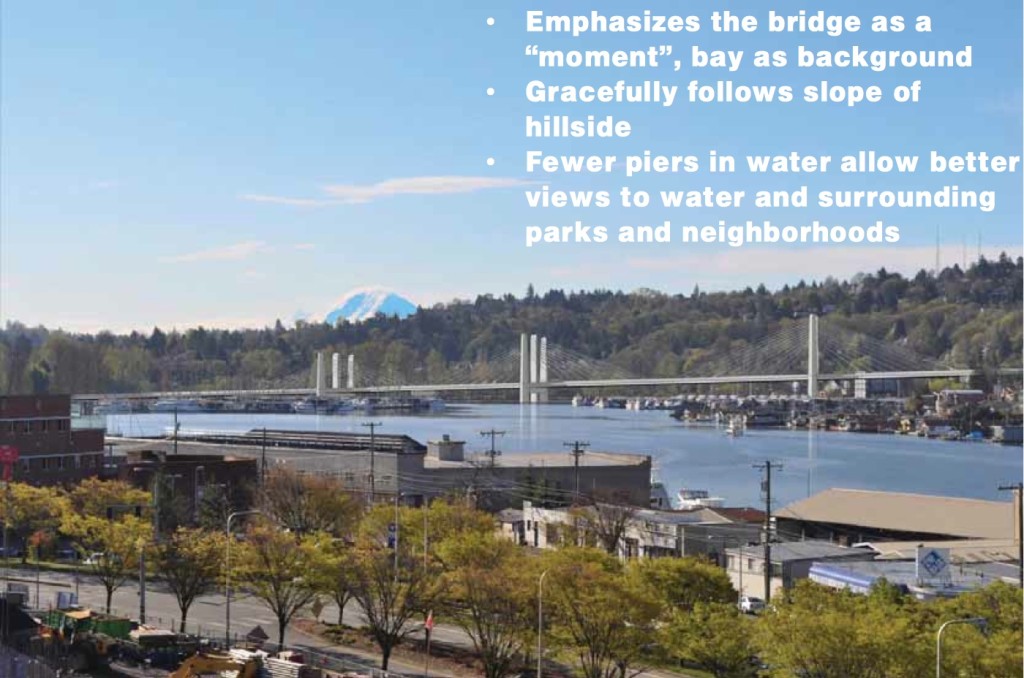
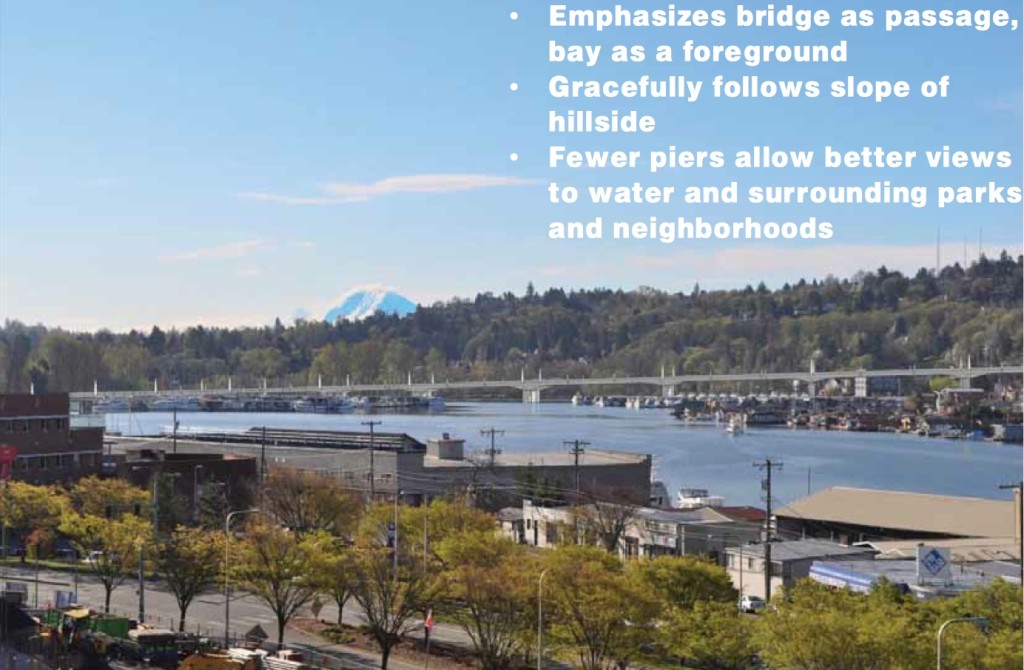
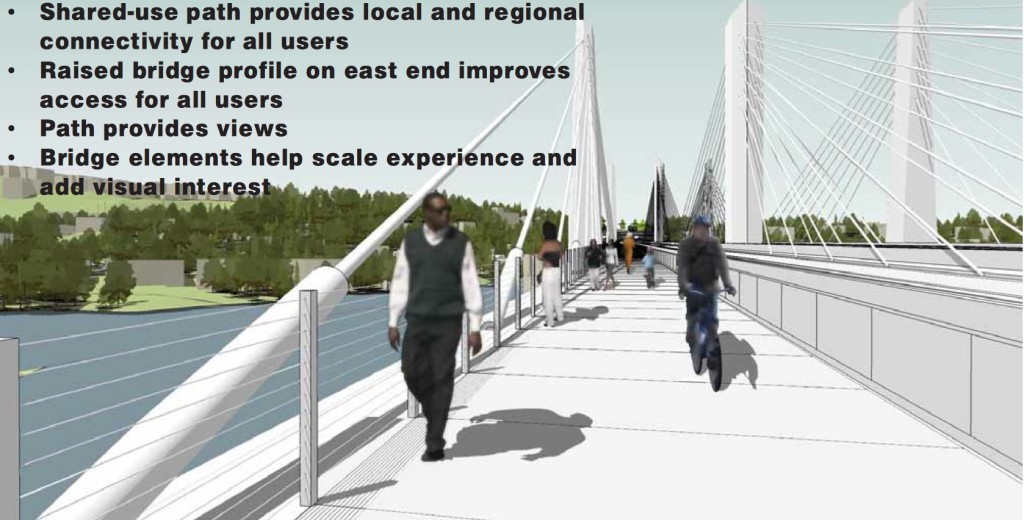
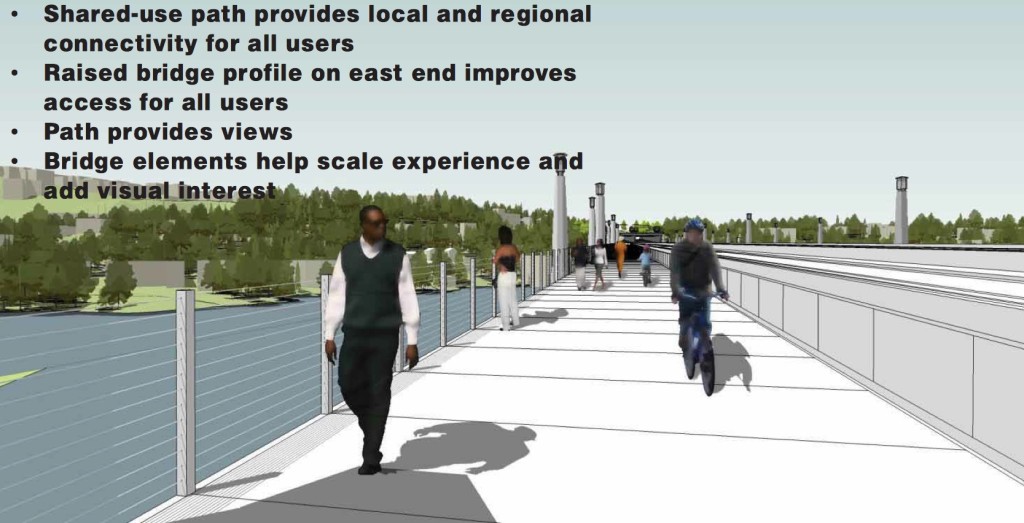
Bruce says
Noise!
And lots of it.
Road noise is one of SR520’s most pervasive impacts in Montlake. WSDOT’s models of a few years ago clearly showed that road-noise levels in many parts of Montlake will increase substantially when the project is complete. Neither west-approach bridge design addresses noise containment/reflection.
While opaque noise walls are entirely unacceptable aesthetically, glass noise reflectors and low barriers covered with sound absorbing material would be a welcome addition to any bridge design. So would a quiet road surface. Every major western European city has some sort of noise protection. It works.
What’s more, imagine the noise level for bicyclists and pedestrians crossing the bridge (not to mention the air quality). At the very least, I’d definitely put a noise-shield canopy on the road-facing side of the ped-bike path.
While we welcome WSDOT’s re-evaluation of their initial designs for the west approach, they’re not looking very hard at the full suite of legacy issues for our present and future residents. That’s one useful lesson of the present road.
jeffp says
Hear! Hear! This comment, not the noise. What a terrible oversight if WSDOT isn’t working on this. Who do we write to ask about their efforts in this regard?
Great insight. I’d vote for a completely ugly bridge if it were quiet.
-Jeff P.
Jill A says
Given the two choices shown (difficult to really appreciate differences in thumbnails on an iPhone), and the fact one design is much more expensive, does it make any difference how we vote? Won’t $$ be the deciding factor in the end???
R McGrew says
This WSDOT article is asking about the Portage Bay bridge, not the Montlake bridge across the ship canal.
J Amick says
This is vital!!!
Change the rules about when the bascule can open – a solitary pleasure boat should not have right-of-way over hundreds of people in vehicles trying to get through Montlake.
Wsdot can talk to Coast Guard. They did after original big committee report in 1999 and I, a citizen, literally followed up saying this needs doing.
On weekends, easy to say bridge only opens between 7-10 am and 2-3 and 9-10 pm. Immoral for a pleasure boat with one vacationing person on it, to stop 1,000 cars, especially for future exiting a $4B new 520.
Pete DeLaunay says
Respect Seattle Leaders Advocates Classic
European Style Portage Bay Bridge Design
We advocate a Portage Bay bridge design that is in keeping with the Olmstead legacy vs. ultra-contemporary bridge design options. This concept was presented to the Seattle Design Commission on 7/17/14.
The Olmstead look, with considerations from the great European bridge designs – London and Paris (and possibly from other European cities) as an aesthetic model for the Portage Bay Bridge.
The rivers through these cities have a width that is similar to Portage Bay and the height above the water is similar. Some of the bridges carry a traffic volume that is similar to the Portage Bay Viaduct. Some of the great European river bridges also carry pedestrian and bicycle traffic with distinctive lighting that makes them very attractive in day and night.
The world’s great urban bridges often accommodate shoreline walks and boat traffic passing underneath. The view of the bridge from the water, shoreline, at street level and from above is carefully considered.
The river bridges of great European cities offer positive visual guidance for a 520 viaduct rebuild.
Tera says
I agree that noise and pollution mitigation, and bicycle and pedestrian access, and traffic flow that does not unduly congest our residential streets are most important for our neighborhood when it comes to the bridge. But what do you recommend we do to help met these priorities? It seems difficult to have a meaningful voice.
Art Haug says
Lionel,
I agree whole-heartedly with you that the City needs to get in the game and that this issue is bigger than just Montlake, so:
THE POINT IS
As Olympia pushes on with 520 while ignoring Montlake
They’ve brought too much traffic for Montlake to take
If Olympia should ultimately get their own way
With their ‘full-of-bad-news’ Preferred Plan A
All thru Montlake it would be a sad day
We would change our name from Montlake to Gridlock
The quickest way through will be to get out and walk
The traffic jams will become an engineering laughing stock
While there still seems to be some time left on the clock
We hope to hear some of our own politicians’ talk
The WS DOT engineers do not even like it
(Though they’ve only said this when it’s in private)
With five traffic lights in just twelve-hundred feet
Those good engineers only sigh in defeat
Olympia teases us with some trivial mitigation
A new pocket park to replace the U-dub police station
And some off-ramp left-turn-lane arrow alterations
And there are more that don’t help the real traffic situation
They hope that by posing these meaningless placations
They will distract the neighbors from outright demonstrations
Of Montlake’s ever-smoldering and outraged frustrations
At the lack of good planning that could be our devastation
It is hopeful to hear we may have our politician’s ear
Montlake prays they will be a little helpful this year
So much of our City has to travel through here
That this is not just the Montlaker’s paranoid fear
A lot of Seattle may soon enjoy their rest stops
At red and green lights in four very short blocks
Lots of time to get out and visit all the Montlake shops
To get a cup of coffee or a beer with some hops
Then back to the car – to find – the bascule’s now popped
The POINT Is: – it is time to end this Olympian parade
– it is time for Olympia to act in good faith
– Seattle’s politicians need to get in the game
– Seattle needs more than Olympia’s Montlake band-aid
If Seattle is ‘in-the-game’ where is their advocacy for their own best interest?
jeffp says
I love the poem, and dread the reality of what has been taking place. In this endgame which played out early between Sound Transit, UDub, WSDOT and Kemper Freeman, our neighborhood and those living in Madison Park, Madrona, & Capitol Hill who routinely transit our neighborhood, have been given airtime & ignored. Not to mention how these big money/influence players preferred the notion of two major thoroughfares (520 & Sound Transit) crossing over/under each other and not intersecting.
If there were something to hope for, perhaps it will be the resulting mess in coming years will produce the political will for those who maybe, actually, represent us in Seattle & Olympia, to retrofit light rail line along 520 from Montlake to Redmond, convert Kemper Freeman’s & other Bellevue Square holdings near the 520/Montlake interchange into a giant, modern urban mass transit terminal, and eliminate the need for so many automobiles to be making these thousands of commuting journeys. I am naive, and tend to assume common sense might some day win out.
Meanwhile, the question is how will our little neighborhood survive the years of traffic jams we have been doomed to? Can we ban everyone from Madision Park, and other parts south from using 520, or will hours spent at the inadequate 520 access in Montlake convince them all to use I-90, move elsewhere or commit seppeku?
-Jeff P.
Andres says
Let’s ensure there’s less congestion by making safe, comfortable connections for people who choose to walk and bike across the bridge. Let’s make sure that someone who decides to try walking or biking across the bridge is not absolutely terrified by the experience. There are lots of people who would walk or bike if they felt safe or if the journey were pleasant. My wife currently bikes to Montlake, and takes the bus across the bridge. Biking or walking around Montlake right now is awful for her.
Art Haug says
Art agrees with Erik and somewhat with Lionel. Montlakers SHOULD care about the look of this bridge because its presence will create noise and dominate the area north of Montlake Playfield and all residents within hearing and viewing distance.
Lionel’s points regarding pedestrian/bicycle connections needing careful development to ensure safe travel in all directions through Montlake are paramount. Pedestrian and bicycle paths should be independent of motor traffic so as not to hold up everyone in the inevitable grid-lock of the new Montlake surface interchange.
Change the rules about when the bascule can open – a solitary pleasure boat should not have right-of-way over hundreds of people in vehicles trying to get through Montlake.
As to the proposed designs, they can both be made to have a thinner and lighter appearance than currently shown by some careful architectural thought. WSDOT needs to hire some professional design folks to make either choice worth doing.
Lionel says
Great point about changing the rules about when the bridge opens. Why are a few people allowed to inconvenience thousands?
Boats are part of our local culture, but there needs to be a way to avoid causing back-ups extending a mile or more in either direction of Montlake Blvd. Signalization, restricted open boat crossing hours? Probably a combination of the two. What do you think?
And also, another great point about separation of bike, peds and cars. It is fundamental and to the benefit of every road user. It shouldn’t be an afterthought patched together at the last mn.
A better Montlake interchange should allow true integration of all the transit modes: on foot, on bike, by bus, by car, by light rail, and even by boat and in a manner respectful or even leveraging the Olmsted legacy of the neighborhood -the system of parks around Montlake, the Arboretum and the UW are a real treasure of our region. All modes of transportation can be combined in Montlake, or rather should be combined since they all merge into one tiny piece of real estate, but we are not seeing long term plans yet that show this real integration.
The plans for the Montlake interchange have all along lacked a real vision. There doesn’t seem to be an architect coordinating the action, but rather a bunch of disconnected engineering teams answering to different governments (the UW, King County, Olympia, the city of Seattle, Sound transit).
It’s time for the city to sort out this mess, don’t you think?
Barbara Wright says
It is hard to tell from the design photos which is better. Both are stlll very bulky and unattractive. I would like the design that provides open, unobstructed views for pedestrians and bicyclists crossing the bridge. As Lionel has said, ped and bike connections going west, east and north are critical to any design and we should not compromise until we get this.
Lionel says
The bridge design choice is interesting but of little consequence for Montlakers since there will be virtually no proper point of view publicly accessible in Montlake proper.
It is much more critical to us to obtain critical safe pedestrian and bicycle crossings on the west side of Montlake blvd as well as on the east side AND also across Montlake blvd itself.
The creation of these connections is a necessity for the neighborhood as well as for any commuters on foot or bicycle crossing the area, and hoping to make their way to the Light Rail Station, the UW Hospital, the UW, or the Burke Gilman trail.
Let’s hope these connections are given the level of priority they deserve by our city and WSDOT.
Carl says
If the Montlake community took a stronger stand for preservation of the Montlake Flyer freeway stations – like they have been built at Yarrow Point and Evergreen Point – then it would become logical that improved pedestrian passages would also be needed to Montlake. As it is the Montlake area design seem to care almost entirely about auto traffic, and they underinvest in both pedestrians and transit.
Erik says
Now just imagine this in a few years as an old bunch of grey concrete and a lot less pretty than the design images…both options are pretty ugly.